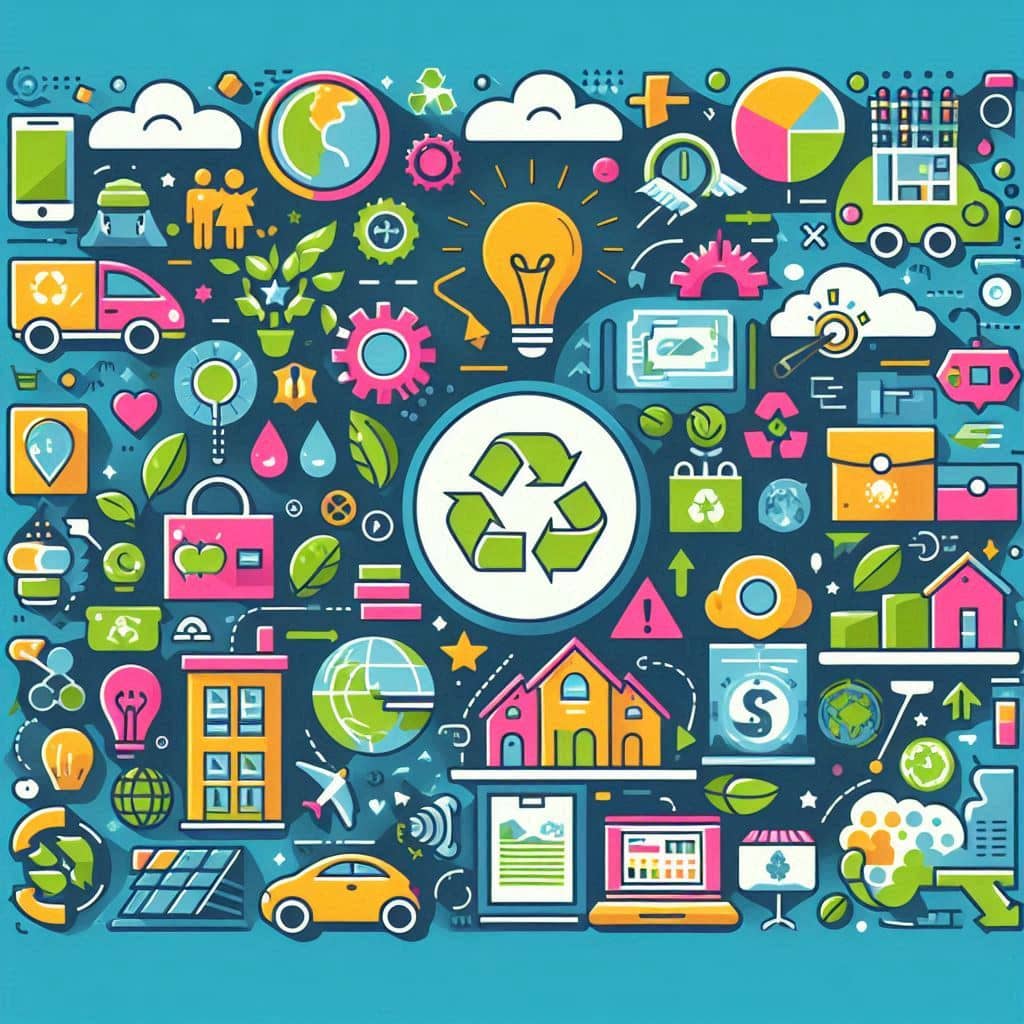List of Sustainable Activities

The list below is based on the experiences of companies and is only a recommendation. The list of measures is not final. Rather, it serves to inspire and guide companies on how to become more sustainable and resilient to the challenges that future developments will bring.
The list is divided into 10 topics (= topics of VSME Standard):
1. Climate Change

Reducing Carbon Emissions in Daily Operations
- Switching to eco-friendly transportation methods.
- Reducing fossil fuel consumption.
- Using alternative fuels.
- Participating in emission reduction programs.
- Collaborating with suppliers to reduce emissions.
- Introducing decarbonization strategies.
- Offsetting carbon emissions.
- Implementing carbon footprint accountability systems.
Improving Energy Use and Efficiency
- Switching to LED lighting.
- Optimizing energy-intensive processes.
- Installing building automation systems and smart thermostats.
- Investing in waste-to-energy, biogas, or cogeneration systems.
- Strengthening insulation and using materials and windows that reflect heat.
- Using energy-efficient cooling systems.
- Monitoring energy consumption digitally.
Incorporating Renewable Energy Solutions
Installing photovoltaic systems or participating in wind turbine investments.
Procuring renewable electricity through long-term purchase agreements.
Using solar, wind, geothermal energy, or biomass.
Supporting renewable energy start-ups and community energy projects.
Supporting Resilient Infrastructure
- Investing in green infrastructure.
- Installing green roofs and facades.
- Ensuring flood resilience through measures like permeable pathways, rain gardens, and elevating infrastructure.
- Supporting carbon-neutral buildings.
Community and Collaborative Efforts
- Supporting community climate and energy initiatives.
- Collaborating with NGOs on climate projects.
- Supporting public policies focused on climate change and sustainability.
- Promoting awareness and education on climate adaptation and mitigation efforts.
Adopting Sustainable Logistics and Supply Chain Practices
- Supporting sustainable logistics systems.
- Reducing the carbon impact of transportation routes and storage facilities.
- Using low-carbon impact substitute materials in supply chains.
Promoting Innovation and Clean Technologies
- Supporting research and development of clean technologies.
- Adopting climate-related innovations in operations.
- Implementing strategies for capturing carbon emissions.
- Using ecological accounting to measure and evaluate the company’s environmental impact.
2. Pollution

Waste Reduction and Recycling
- Reducing waste production.
- Implementing recycling programs.
- Introducing systems for waste sorting.
- Reducing the use of single-use plastics.
- Introducing eco-friendly packaging materials.
- Supporting programs for textile waste recycling.
- Encouraging zero-waste policies in offices.
- Supporting community recycling programs.
- Supporting initiatives focused on waste reduction.
Pollution Control and Prevention
- Monitoring and minimizing emissions of pollutants.
- Using eco-friendly cleaning products.
- Managing and reducing chemicals.
- Limiting the use of toxic substances.
- Introducing low-emission technologies.
- Controlling air pollution through monitoring systems.
- Supporting research on microplastic elimination.
- Implementing programs to eliminate pesticides.
- Reducing emissions from transportation.
Water and Soil Conservation
- Reducing water consumption.
- Treating wastewater.
- Using natural filters to clean water.
- Implementing water-efficient management systems.
- Supporting projects for soil regeneration.
- Promoting sustainable agricultural practices.
- Supporting ecological farming.
Green Urban Development
- Establishing green spaces in urban areas.
- Supporting green infrastructure in cities.
- Encouraging the installation of green roofs and walls.
- Removing illegal dumps.
- Promoting noise reduction measures.
Community and Educational Initiatives
- Supporting community cleanup actions.
- Introducing environmental education programs.
- Raising awareness about ecological responsibility.
- Supporting educational initiatives about pollution.
Innovation and Research
- Supporting research on alternative materials.
- Encouraging research to improve air quality.
- Promoting research on pollution-reduction technologies.
- Supporting start-ups addressing pollution issues.
Sustainable Procurement and Green Certifications
- Introducing green public procurement practices.
- Supporting ecological product certifications.
- Introducing eco-labels for products.
Collaborations and Partnerships
- Working with local authorities to protect the environment.
- Partnering with scientists to support environmental protection.
Renewable Energy and Eco-Friendly Production
- Using renewable energy sources in production.
- Supporting the adoption of eco-friendly production technologies.
3. Water and Marine Resources

Efficient Water Use and Conservation
- Reducing water consumption.
- Implementing efficient irrigation systems.
- Installing rainwater harvesting systems for non-potable uses such as cleaning, irrigation, landscaping, or cooling processes.
- Reusing process or wastewater through closed-loop filtration or gray water recycling.
- Optimizing water-intensive processes.
- Installing low-flow fixtures or smart irrigation systems.
- Using IoT sensors to measure and monitor water usage in real-time.
- Installing water-saving cooling technologies.
Wastewater Management and Pollution Control
- Treating wastewater.
- Reducing water pollution.
- Introducing wastewater treatment systems on-site at manufacturing facilities.
- Implementing systems for wastewater recycling.
- Reducing emissions into water bodies.
- Introducing technologies for detecting water leaks.
- Supporting initiatives to reduce plastic waste in oceans.
- Introducing measures to control pollution from shipping.
Protecting Water and Marine Ecosystems
- Supporting projects to protect water resources.
- Protecting and restoring wetlands.
- Supporting projects to restore marine ecosystems.
- Protecting groundwater resources.
- Supporting freshwater ecosystem protection projects.
- Protecting coral reefs.
- Supporting projects for mangrove restoration.
- Creating artificial reefs to protect marine life.
- Supporting projects for the protection of aquatic plants.
- Introducing programs for the conservation of marine birds and mammals.
Community and Collaborative Efforts
- Collaborating with local communities to protect water resources.
- Partnering with non-governmental organizations on water conservation projects.
- Collaborating with scientific institutions to safeguard water resources.
- Partnering with governmental and non-governmental organizations on water ecosystem protection.
- Supporting community projects to protect water.
Sustainable Agricultural Practices
- Reducing water consumption in agriculture.
- Supporting sustainable fishing practices.
- Supporting initiatives to reduce pesticides and fertilizers in agriculture.
Innovative Technologies and Research
- Using modern technologies to save water.
- Supporting research and development in water resource protection.
- Supporting research aimed at improving water quality.
- Introducing systems for desalination of seawater.
- Implementing systems for monitoring water quality.
Raising Awareness and Education
- Supporting educational programs on water conservation.
- Promoting awareness about water-saving practices.
- Training employees on water protection methods.
Policy and Certification Programs
- Implementing a zero water pollution policy.
- Introducing ecological certifications for water management projects.
Risk Management in Water-Stressed Areas
- Assessing water scarcity risks for operational sites.
- Collaborating with local utilities or third-party services to identify alternative sourcing options.
4. Biodiversity and Ecosystems

Protecting and Restoring Natural Ecosystems
- Protecting endangered species
- Supporting projects to restore natural habitats
- Protecting and restoring natural resources
- Supporting projects to restore wetlands and marshes
- Supporting projects to restore coastal ecosystems
- Implementing programs to restore degraded ecosystems
- Establishing green corridors for wildlife movement
- Protecting natural parks and reserves
- Creating and protecting natural protected areas
Sustainable Agriculture and Land Management
- Using ecological farming practices
- Reducing pesticide and herbicide usage
- Supporting sustainable forestry
- Introducing programs to protect soil
- Supporting ecological farming projects
- Implementing programs for soil erosion prevention
- Protecting traditional agricultural areas
- Introducing sustainable forestry policies
Community and Collaboration Efforts
- Supporting community environmental initiatives
- Supporting community gardens and urban green spaces
- Collaborating with local communities on nature conservation
- Collaborating with non-governmental organizations on nature conservation
- Partnering with scientific institutions to safeguard ecosystems
Technological and Innovative Solutions
- Using modern technologies for ecosystem monitoring
- Supporting research and development in biodiversity protection
- Supporting research focused on biodiversity
- Encouraging start-ups focused on ecological innovations
Biodiversity Preservation
- Introducing biodiversity protection programs
- Implementing programs to protect local plant species
- Protecting the genetic diversity of agricultural crops
- Supporting initiatives to protect wildlife
- Supporting initiatives to protect pollinators and insects
- Implementing programs to protect soil microorganisms
Reducing Environmental Impact
- Minimizing the impact on natural ecosystems
- Limiting resource extraction from natural habitats
- Reducing watercourse pollution
- Reducing plastic use in agriculture
- Introducing deforestation prevention policies
Wetland and Forest Conservation
- Supporting wetland restoration projects
- Supporting projects to protect and restore wetlands
- Supporting reforestation projects
Educational and Awareness Initiatives
- Supporting education and awareness on nature conservation
- Supporting ecotourism
5. Circular Economy

Waste Management and Recycling
- Implement programs for recycling and reusing materials.
- Introduce waste sorting systems to enable reuse or recycling.
- Use recycled materials in production.
- Support recycling programs for electronics, automotive parts, textiles, and pharmaceuticals.
- Implement waste monitoring and reduction systems.
- Train employees in waste management practices and separated material handling.
- Promote zero-waste policies in industrial processes.
- Support community recycling initiatives.
Sustainable Packaging and Materials
- Use eco-friendly or biodegradable packaging materials.
- Encourage the reduction of single-use products.
- Support research into recyclable or renewable material inputs.
- Promote the use of sustainable product designs that enhance durability and repairability.
- Avoid hazardous materials or replace them with safer alternatives.
- Support research and innovation in sustainable materials.
Resource Efficiency and Circular Processes
- Implement systems for reusing or repurposing materials.
- Support projects focused on repurposing products and buildings.
- Encourage upcycling and downcycling programs.
- Collaborate with suppliers to introduce circular processes.
- Use modern technologies to monitor and optimize resource usage.
- Implement systems to track and improve resource utilization efficiency.
Circular Economy Innovations
- Support research and development in circular economy technologies.
- Encourage innovation in circular processes for production and consumption.
- Promote start-ups focused on renewable or sustainable material solutions.
- Develop life-cycle tracking systems for products to enhance transparency.
Education and Awareness
- Support training and awareness programs on circular economy principles.
- Encourage education on efficient resource management and waste reduction.
- Promote initiatives that raise awareness about sustainable material usage.
Sustainable Production and Design
- Support sustainable product development.
- Incorporate closed-loop filtration and gray water recycling in production.
- Implement systems to optimize industrial processes and reduce emissions during recycling.
- Establish policies for reusing waste heat, water, and construction materials.
- Design products for easy maintenance, reusability, or recycling.
Community and Collaborative Initiatives
- Partner with local communities to promote material reuse and recycling.
- Collaborate with suppliers and stakeholders to establish shared circular strategies.
- Support community projects focused on waste reduction and resource recovery.
6. Own Workforce

Employee Health and Well-Being
- Implement physical health initiatives, such as offering gym memberships, organizing fitness challenges, or providing ergonomic office equipment.
- Provide mental health support, including access to counseling, stress management workshops, and employee assistance programs.
- Promote healthy lifestyles by offering nutritional guidance, healthy meal options at the workplace, and wellness programs.
- Address stress management with relaxation rooms, mindfulness training, or flexible work arrangements to reduce burnout risks.
- Ensure the workplace is safe and healthy, with regular inspections, hazard assessments, and emergency preparedness plans.
Workplace Inclusivity and Diversity
- Develop and enforce zero-tolerance policies for discrimination, with regular training to prevent harassment and bias.
- Promote cultural and ethnic diversity, ensuring inclusivity through cross-cultural awareness programs and celebrations of diversity.
- Support the LGBTQ+ community through dedicated programs, benefits, and inclusive company policies.
- Encourage gender equality, offering mentorship programs for women and ensuring equal opportunities for advancement.
- Recognize the value of older employees by introducing flexible retirement plans and mentorship opportunities.
Professional Growth and Development
- Provide professional training opportunities, such as skill-building workshops, online courses, and certifications.
- Create systems for career development, including clear pathways for promotion and opportunities for employees to set personal development goals.
- Establish leadership development programs to prepare employees for management roles.
- Support mentoring programs that allow experienced staff to guide and mentor newer employees.
- Offer access to educational conferences and seminars to encourage ongoing learning.
Flexible and Inclusive Work Environment
- Foster workplace flexibility by allowing remote work, flexible hours, and job-sharing arrangements.
- Implement family-friendly policies, such as generous parental leave, childcare support, and family health benefits.
- Promote a healthy work-life balance by limiting overtime and encouraging personal time.
- Encourage intergenerational collaboration by facilitating knowledge-sharing initiatives and integrating mixed-age teams.
Sustainability and Environmental Actions
- Support sustainable workplace practices, such as waste reduction programs, energy-efficient equipment, and paperless initiatives.
- Encourage sustainable transportation, such as promoting cycling to work, offering public transport benefits, or providing electric vehicle charging stations.
- Introduce eco-friendly benefits, like tree-planting initiatives tied to milestones or providing reusable employee kits (water bottles, lunch containers).
- Support employee-led environmental projects, fostering engagement with green initiatives.
Employee Engagement and Retention
- Develop employee retention programs, focusing on recognition, rewards, and professional growth opportunities.
- Offer comprehensive benefits packages that include health insurance, retirement contributions, and additional perks.
- Create systems for employee feedback, such as regular surveys, anonymous suggestion boxes, and one-on-one check-ins with management.
- Involve employees in decision-making processes, fostering a sense of ownership and inclusion in company strategy.
- Monitor and improve employee satisfaction through tracking systems and regular touchpoints.
Community and Volunteer Involvement
- Encourage volunteer work during working hours by partnering with local charities or organizing volunteer days.
- Support corporate social responsibility (CSR) projects that allow employees to engage with local communities.
Innovation and Creativity in the Workplace
- Establish innovation hubs or dedicate time for employees to work on creative side projects that align with company goals.
- Provide support for research and development, fostering a culture of innovation within the company.
- Recognize and reward creative problem-solving and innovative contributions from employees.
- Incorporate sustainability-focused innovation, encouraging employees to think about environmentally friendly processes and products.
7. Workers in the Value Chain

Fair Treatment and Workers’ Rights
- Implement fair trade policies.
- Introduce programs to protect workers‘ rights.
- Collaborate with labor unions and workers‘ associations.
- Implement zero-tolerance policies for discrimination.
- Establish equality in pay policies.
- Support fair trade products in supply chains.
- Collaborate with organizations to protect workers‘ rights.
- Collaborate with government bodies on labor rights protections.
- Ensure child labor protection programs are in place.
- Promote initiatives to improve working standards and protect workers’ dignity.
Safe and Healthy Work Environments
- Support the health and well-being of workers by implementing health and safety policies.
- Introduce systems for monitoring workplace conditions and occupational health.
- Provide education on workplace safety, including emergency response training.
- Enhance the physical and mental work environment through targeted programs.
- Support mental health initiatives and provide access to counseling services.
- Develop plans for injury prevention and implement personal protective equipment (PPE) standards.
Diversity, Equity, and Inclusion
- Introduce policies to support workplace diversity and cultural inclusivity.
- Implement programs promoting gender equality and equal opportunities.
- Offer leadership coaching and mentoring with a focus on equity.
- Support initiatives for the LGBTQ+ community in the workplace.
- Promote multigenerational collaboration and inclusion of older employees.
Professional Development and Education
- Provide training programs focused on professional growth and sustainable practices.
- Offer career development workshops and monitoring systems for employee growth.
- Support employees’ participation in external educational opportunities.
- Educate workers about labor rights and sustainability in the workplace.
- Collaborate with suppliers to enhance their professional development.
Work-Life Balance and Employee Communities
- Implement programs to support a work-life balance, including flexible work arrangements.
- Provide family-friendly policies such as parental leave and flexible schedules.
- Encourage the formation of work communities and workplace engagement programs.
- Support volunteering initiatives and community engagement during working hours.
Supply Chain and Collaboration
- Collaborate with suppliers to improve workplace conditions and labor standards.
- Introduce supplier codes of conduct to ensure fair labor practices.
- Focus on reducing risks in supply chains, particularly in high-risk areas.
- Support initiatives to improve working conditions in supply chains through partnerships with industrial organizations.
Innovation and Monitoring Systems
- Develop systems to monitor and improve working conditions, employee satisfaction, and labor practices.
- Introduce programs to evaluate and ensure compliance with labor standards.
- Use innovative tools to track occupational health and safety.
Fair Compensation and Transparent Policies
- Conduct pay structure analyses to close gaps and ensure fair wages.
- Create clear, transparent pay scales and communicate them to employees.
- Provide regular updates and reviews of compensation packages and benefits.
8. Affected Communities

Community Development and Engagement
- Support local community projects by partnering with grassroots organizations to address specific needs.
- Collaborate with community leaders and local authorities to improve infrastructure and living conditions.
- Promote cultural and sporting activities, festivals, and events to strengthen community bonds.
- Work with schools, educational institutions, and local businesses to foster economic growth and educational opportunities.
- Partner with local volunteer organizations and support initiatives that involve community members directly.
Access to Essential Services
- Implement programs to improve access to education, healthcare, and nutrition.
- Support initiatives for improving access to clean water and sanitation facilities.
- Develop programs to enhance access to housing and transport services in underprivileged areas.
- Introduce programs for better access to energy and digital technologies, ensuring inclusivity.
Promoting Economic Sustainability
- Support local entrepreneurs, start-ups, and small businesses by providing resources, mentoring, and funding.
- Collaborate with local businesses and supply chains to stimulate economic growth.
- Launch initiatives that improve employment opportunities and income stability for community members.
- Implement programs for the protection and promotion of local cultural heritage and traditions.
Environmental Protection and Conservation
- Develop community-based environmental protection programs, including the conservation of local fauna, flora, and forests.
- Promote initiatives to reduce pollution and improve air, water, and soil quality in the area.
- Support local green projects like community gardens and reforestation efforts.
- Create awareness about sustainable practices and ecological initiatives that benefit the community.
Resilience and Disaster Preparedness
- Implement programs to support communities recovering from natural disasters.
- Collaborate with local organizations to prepare for potential environmental and economic risks.
- Support child safety and protection initiatives in disaster-stricken areas.
Health and Safety Programs
- Support local healthcare facilities, providing resources and training to improve public health services.
- Develop programs to enhance hygiene standards and access to health insurance in underserved communities.
- Promote the protection of children and vulnerable populations through safety initiatives.
Education and Skill Building
- Support educational projects aimed at improving access to quality schooling for all, particularly girls and women.
- Provide vocational training and skill development programs for youth and community members.
- Collaborate with educational institutions to advance learning and career readiness.
9. Consumers and End-Users

Transparent and Informative Communication
- Provide detailed and transparent information about product environmental impacts, energy use, and recycling options.
- Offer consumers insights into life-cycle assessments, sustainable alternatives, and carbon footprint reduction.
- Develop clear labeling systems, including eco-certifications, product origin tracking, and recyclability labels.
- Train staff to deliver accurate, accessible, and comprehensive product information to consumers.
- Create feedback channels for consumers to ask questions or raise concerns about product sustainability.
Sustainable Product Development
- Design and produce biodegradable or low-carbon footprint products.
- Incorporate recycled materials into production processes and offer products made from such materials.
- Provide environmentally friendly packaging solutions to replace conventional materials.
- Implement waste reduction programs during manufacturing to minimize production-related environmental impacts.
- Introduce fair trade policies to support ethical production practices.
Post-Use and Recycling Initiatives
- Establish take-back programs to ensure responsible disposal or recycling of products.
- Support community-driven recycling initiatives and e-waste recycling programs.
- Facilitate the recycling of packaging materials and encourage recycling among end-users.
- Promote circular economy efforts by supporting initiatives to reduce plastic waste and recycle textiles.
Customer Education and Engagement
- Launch educational campaigns on sustainable consumer behavior and responsible purchasing.
- Offer workshops or digital resources to inform customers about protecting the environment through product choices.
- Support sustainability-focused consumer education initiatives in local communities.
- Educate consumers on sustainable fashion, fair trade, and eco-conscious agricultural practices.
Monitoring and Accountability
- Implement systems to track product environmental impacts, including water, energy, and emissions.
- Monitor compliance with environmental standards throughout the production and supply chain.
- Regularly assess and improve the accuracy of sustainability claims and certifications.
- Collaborate with relevant organizations to ensure ethical and eco-friendly practices.
Innovative and Eco-Friendly Alternatives
- Develop and market ecological product alternatives to traditional items.
- Support research and innovation in renewable, biodegradable, or low-impact materials.
- Promote green innovation through partnerships with sustainable start-ups and suppliers.
Supporting Local and Global Sustainability Efforts
- Promote local sourcing by supporting regional manufacturers and utilizing local raw materials.
- Partner with organizations to protect natural resources and reduce environmental footprints.
- Encourage fair trade initiatives by prioritizing ethically produced goods in the supply chain.
Energy and Water Efficiency
- Develop products that consume less energy and water, incorporating these efficiencies into their design.
- Educate consumers on reducing energy and water consumption through responsible product use.
- Implement manufacturing practices that reduce energy and water use to improve overall efficiency.
Advancing Consumer Rights
- Implement programs to protect consumer rights, ensuring ethical and safe product standards.
- Collaborate with consumer organizations to address typical concerns and enhance trust in products.
- Ensure products and services are accessible to diverse consumer groups, including people with disabilities and older adults.
10. Business Conduct

Ethical Business Practices
- Establish ethical business policies to promote accountability and integrity.
- Implement zero-tolerance policies for unethical behavior, such as corruption or bribery.
- Develop responsible marketing policies that ensure truthfulness and transparency.
- Introduce policies to protect intellectual property and customer data.
- Promote responsible investment practices that align with ethical and sustainable principles.
Transparency and Accountability
- Enhance transparency in business processes, decision-making, financial transactions, and manufacturing.
- Support supplier transparency by requiring clear communication about labor and environmental standards.
- Monitor ethical, social, and environmental standards in supply chains through dedicated systems.
- Create systems for tracking and improving workplace and environmental conditions across the supply chain.
Worker Rights and Fair Practices
- Promote diversity and inclusion through policies and workplace initiatives.
- Implement programs to improve worker rights and protect against discrimination.
- Establish equal pay policies and actively address pay gaps.
- Collaborate with workers and organizations to improve labor conditions both within the company and in supply chains.
- Support initiatives to protect human rights and create fair working conditions.
Sustainability in Business Operations
- Develop policies to mitigate environmental impacts and conserve natural resources.
- Promote ecological initiatives in supply chains and within the company.
- Introduce systems to monitor and improve environmental standards in manufacturing and sourcing.
- Support initiatives for sustainability and environmental conservation.
Building a Positive Workplace Culture
- Clearly define the company’s mission, values, and standards of conduct in a code of ethics.
- Provide regular training for employees, using real-life examples to reinforce ethical practices.
- Create clear communication channels for reporting concerns or violations, ensuring confidentiality.
- Foster collaboration between employees, suppliers, and external organizations to achieve shared goals.
Supplier Collaboration and Management
- Choose small or local suppliers to support economic development and reduce carbon footprints.
- Set clear expectations for suppliers regarding social and environmental standards.
- Collaborate with suppliers to define sustainability objectives and foster long-term partnerships.
- Establish fair payment terms for suppliers and communicate them transparently.
Monitoring and Improvement Systems
- Implement systems to track ethical, social, and environmental standards internally and within supply chains.
- Regularly assess and improve business processes to align with sustainability goals.
- Monitor employee satisfaction and working conditions to ensure a positive workplace environment.
Education and Awareness
- Provide training for employees on topics such as ethical business practices, anti-corruption measures, and human rights.
- Educate employees and suppliers about sustainable goals and encourage innovation in ethical practices.
- Collaborate with community organizations to raise awareness about responsible business operations.
